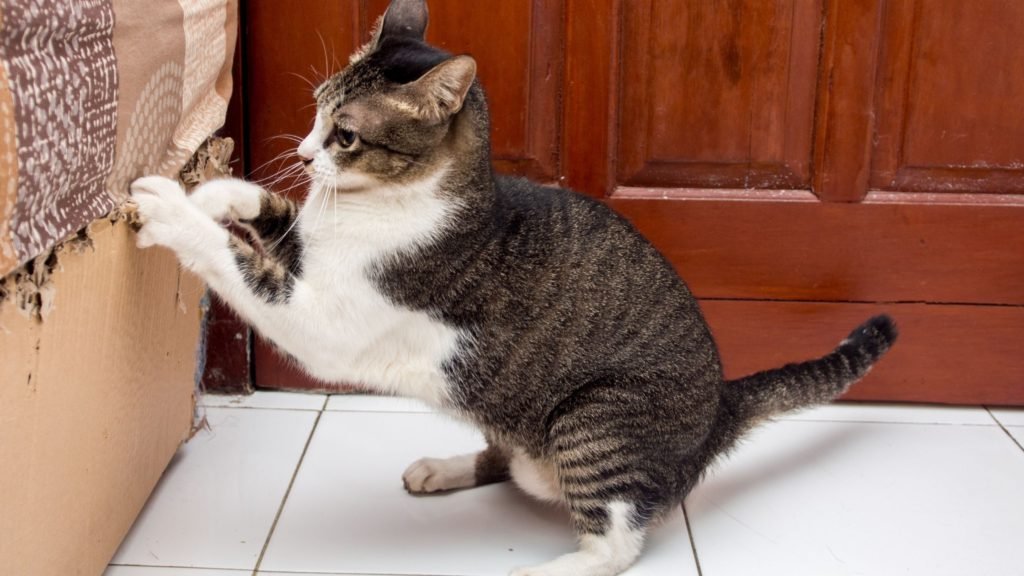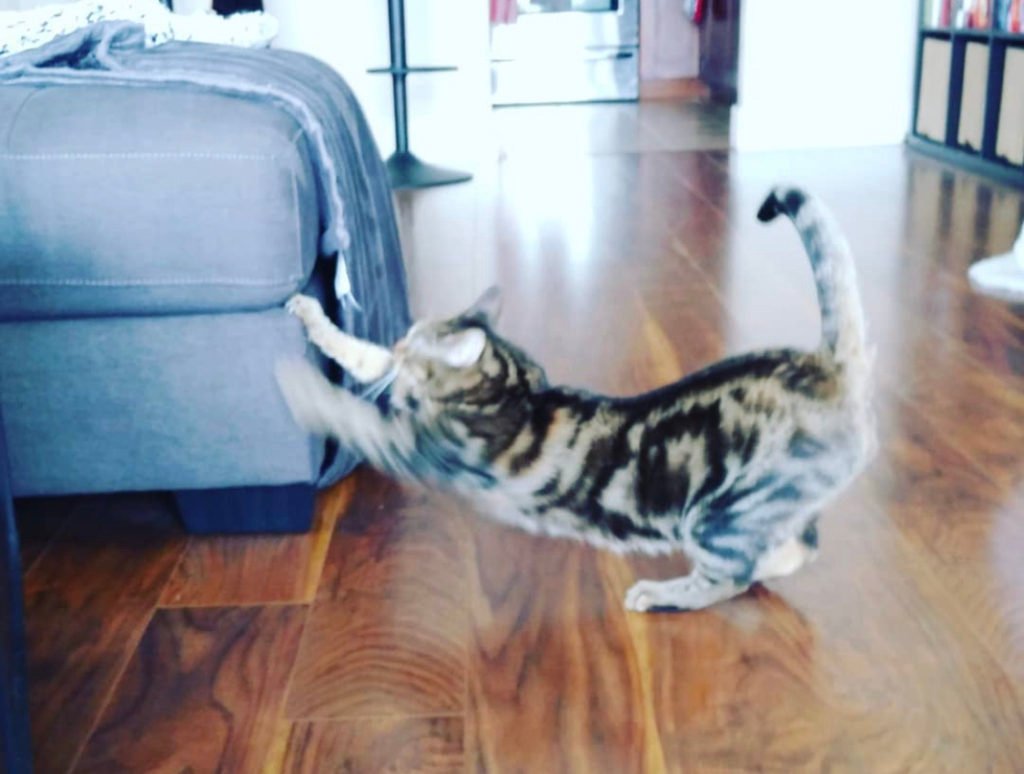Tired of scratched furniture? Our guide on how to train your cat not to scratch offers expert tips and advice to help you and your cat live harmoniously.
Why Do Cats Scratch?
Before diving into the training process, it’s essential to understand why cats scratch in the first place. Scratching is a natural behavior for cats, as it helps them:
- Sharpen and maintain their claws
- Stretch their muscles
- Mark their territory with scent glands in their paws
Understanding these reasons can help you provide alternatives for your cat and make the training process more successful.
How to Train Your Cat Not to Scratch You
To prevent your cat from scratching you, follow these steps:
- Observe your cat’s body language: Learn to recognize signs of agitation or distress in your cat, such as flattened ears, twitching tail, or raised fur. Avoid interacting with your cat when they show these signs.
- Redirect aggressive play: If your cat gets too rough during play, immediately stop and redirect their attention to a toy.
- Use positive reinforcement: Praise and reward your cat when they display gentle behavior, like retracting its claws during play.
- Avoid punishment: Physical or verbal punishment can create fear and anxiety, worsening the problem. Instead, focus on positive reinforcement.

How to Train Your Cat Not to Scratch Furniture
To protect your furniture from your cat’s claws, follow these steps:
- Provide scratching alternatives: Offer your cat various scratching posts and pads near their favorite spots.
- Apply deterrents: Use double-sided tape, aluminum foil, or commercial scratch repellents on furniture to make it less appealing to your cat.
- Use positive reinforcement: Reward your cat when they use their scratching posts or pads instead of your furniture.
- Trim your cat’s nails regularly: Trimming your cat’s claws can help minimize damage to your furniture.
You May Also Interest: Becoming a Cat Groomer: Unlock a Rewarding Career
How to Train Your Cat Not to Scratch tusing the Scratching Post
Introducing a scratching post to your cat involves the following steps:
- Choose the right post: Select a scratching post that is sturdy, tall enough for your cat to stretch, and covered in a material your cat likes, such as sisal or carpet.
- Position the post strategically: Place the scratching post near your cat’s favorite scratching spots, sleeping areas, or near the entrance to a room.
- Please make the most appealing: Encourage your cat to use the post by rubbing catnip, dangling toys, or placing treats near it.
- Use positive reinforcement: Praise and reward your cat when they use the scratching post.
How to Train Your Cat Not to Scratch: Cat Crate Training
Crate training can help teach your cat not to scratch by providing a controlled environment for training. Here’s how to do it:
- Choose a comfortable crate: Ensure the crate is large enough for your cat to stand, turn around, and stretch comfortably.
- Make the crate inviting: Place a soft bed, toys, and a scratching post inside to make it appealing.
- Introduce your cat to the crate gradually: Start by leaving the door open and allowing your cat to explore it at their own pace. Reward them for entering the crate voluntarily.
- Begin short training sessions: Close the crate door briefly, gradually increasing the duration as your cat becomes comfortable. Reward your cat for not scratching while in the crate.
How to Train Your Cat Not to Scratch Consistency and Patience
Consistency and patience are crucial factors in successfully training your cat not to scratch. It’s essential to:
- Maintain a consistent routine: Stick to a regular schedule for playtime, feeding, and grooming, as this helps create a sense of security for your cat and reduces stress-related scratching.
- Be patient: Training your cat not to scratch may take time, as you’re working to change ingrained habits. Celebrate small successes and understand that setbacks are part of the process.
- Seek professional help if needed: If your cat’s scratching behavior doesn’t improve despite your efforts, consult a veterinarian or a professional cat behaviorist for guidance.

Preventing Boredom-Related Scratching
Boredom can lead to destructive behaviors, including scratching. To keep your cat entertained and reduce boredom-related scratching, consider the following strategies:
- Provide interactive toys: Offer a variety of toys that stimulate your cat’s hunting instincts, such as puzzle toys, laser pointers, and toys with feathers or other enticing textures.
- Engage in regular play sessions: Dedicate at least two 15-minute play sessions daily to stimulate your cat mentally and physically.
- Rotate toys: Regularly change your cat’s toys to keep them interested and engaged.
- Offer vertical space: Cats love to climb and explore. Provide cat trees, shelves, or window perches to give your cat more opportunities for exploration and exercise.
Addressing Stress and Anxiety-Related Scratching
Cats may scratch more frequently when they feel stressed or anxious. Identifying and addressing the causes of stress can help reduce unwanted scratching. Consider these tips:
- Maintain a consistent routine: Cats thrive on predictability. Establish a daily routine for feeding, playtime, and grooming to create a sense of security.
- Provide hiding spots and safe spaces: Cats feel safer accessing hiding spots, such as boxes, cubbies, or elevated perches.
- Use calming aids: Consider using pheromone diffusers, calming collars, or calming supplements to help reduce your cat’s anxiety.
- Identify and address stressors: Observe your cat’s behavior and environment to identify potential stressors, such as loud noises, changes in the household, or conflicts with other pets. Address these stressors when possible.
You May Also Interest: The Ultimate Guide to Cage Training a Cat: Tips and Techniques

Training Your Cat Not to Scratch During Playtime
Cats may scratch during play, especially when they get overly excited. Teaching your cat appropriate play behaviors can help prevent scratching:
- Use appropriate toys: Avoid using your hands or fingers as toys, as this can encourage your cat to scratch. Instead, use toys that allow for distance between your hands and the toy, such as wand toys or toys attached to a string.
- Encourage gentle play: Praise and reward your cat for playing gently without scratching. If your cat begins to mark, immediately stop the play session and redirect their attention to an appropriate toy.
- Establish a play routine: Schedule regular play sessions to help your cat expend energy and reduce the likelihood of unwanted scratching.
- Teach the “soft paws” command: Train your cat to retract its claws during play by gently touching them and saying “soft paws” or another chosen order. Reward your cat when they reject its claws.
The Importance of Proper Nail Care
Regular nail care can help reduce the damage caused by your cat’s scratching. Here are some tips for maintaining your cat’s nails:
- Trim your cat’s nails regularly: Aim to trim them every 2-3 weeks to keep them short and blunt, which can minimize the damage caused by scratching. Make nail trimming a positive experience by using treats and praise.
- Use nail caps: Nail caps are small plastic covers that can be applied to your cat’s nails. They provide a temporary solution for preventing damage caused by scratching without interfering with your cat’s natural behavior.
- Monitor nail health: Regularly check your cat’s nails for signs of injury, infection, or overgrowth. If you notice any issues, consult your veterinarian for advice.
Socializing Your Cat with Other Pets
If you have other pets in your household, it’s essential to establish a harmonious relationship among them to reduce stress and territorial scratching. Follow these steps to introduce your cat to other pets:
- Begin with scent exchange: Swap bedding or toys between your cat and the other pet to familiarize them with each other’s scents.
- Use a barrier for the first introduction: Keep your cat and the other pet separated by a door or baby gate during their initial meeting to allow them to observe each other safely.
- Supervise interactions: Monitor your cat and the other pet during their interactions and intervene if any signs of aggression or fear arise.
- Encourage positive associations: Reward both pets with treats, praise, or play when they display calm and non-aggressive behaviors around each other.
- Gradually increase the time spent together: As your pets become more comfortable with each other, allow them to spend more time together under supervision.

You May Also Interest: Proven Techniques for the Best Way to Train Cats
Troubleshooting Common Training Challenges
You may encounter some challenges while training your cat not to scratch. Here are some common issues and tips for overcoming them:
- Your cat ignores the scratching post: Make the post more enticing by rubbing catnip on it, placing treats nearby, or using toys to encourage interaction. Ensure the post is sturdy, tall enough for your cat to stretch, and covered in a material your cat prefers.
- Your cat continues to scratch furniture: Be consistent with deterrents, such as double-sided tape or aluminum foil, and reinforce positive behaviors when using the scratching post. If needed, consider using temporary barriers, such as baby gates, to restrict access to the furniture.
- Your cat scratches during playtime: Redirect your cat’s attention to appropriate toys when they scratch during play. Establish a routine for play sessions and encourage gentle play.
- Your cat’s scratching is stress-related: Identify and address potential stressors in your cat’s environment. Maintain a consistent routine, provide safe spaces and hiding spots, and consider using calming aids.
When to Consult a Professional
Consulting a professional is essential if you’ve tried all the recommended strategies and your cat continues to scratch inappropriately. A veterinarian or a certified cat behaviorist can provide personalized guidance and develop a tailored training plan to address your cat’s specific needs.
Conclusion
Training your cat not to scratch is a process that requires patience, consistency, and understanding. Following the tips in this guide, you can teach your cat to use appropriate scratching surfaces, protect your furniture, and enjoy a scratch-free home. Remember that setbacks are a normal part of the training process, and don’t hesitate to seek professional help if needed. You and your cat can enjoy a harmonious, scratch-free relationship with time, dedication, and effort.

